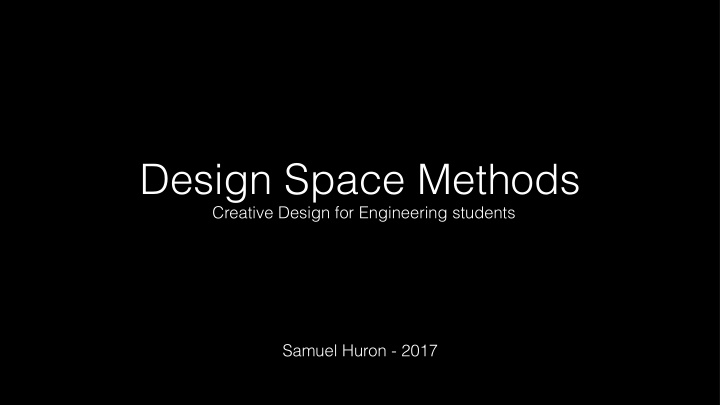



Design Space Methods Creative Design for Engineering students Samuel Huron - 2017
“As for any technology area, it is necessary to develop abstractions that rise above particular point designs in order to allow this codification of art into technology to occur.” –Stuart K. Card and Jock Mackinlay
• Feedback on your work • How to present a design space? • Expected results?
Feedback
Representation ?
What is a design pattern?
“A design pattern is the re-usable form of a solution to a design problem. ”
going up
Design space presentation patterns
Design space presentation patterns 1. Claim of usefulness (why,what,how, 5. Case study : Present individual case for who, when…) position inside the design space. 2. Representation Figure with caption 6. Description of speculative artefacts and explanation for presenting the inside the space. space 7. Lessons: What did we learn? 3. Description of each individual 8. Tell a Story: Present the space from dimensions the perspective of the decision 4. Exemplification : of the dimensions maker. by properties of existing artefact
1. Claim of usefulness
2. Figure with caption and explanation for presenting the space
The Design Space of Wireless Sensor Networks ∗
Dimensions solutions The Design Space of Wireless Sensor Networks ∗
Narrative Visualization: Telling Stories with Data
Dimensions Types of dimensions solutions Dimensions Highlight Visualisation sources Empty Narrative Visualization: Telling Stories with Data
Narrative Visualization: Telling Stories with Data
Unfolding the Earth: Myriahedral Projections
The Structure of the Information Visualization Design Space
The Structure of the Information Visualization Design Space
The Structure of the Information Visualization Design Space
Bricks: Laying the Foundations for Graspable User Interfaces
Visual Sedimentation
The Design Space of Implicit Hierarchy Visualization: A Survey
3. Description of each individual dimensions
Dimensions solutions The Design Space of Wireless Sensor Networks ∗
Narrative Visualization: Telling Stories with Data
Narrative Visualization: Telling Stories with Data
Narrative Visualization: Telling Stories with Data
Unfolding the Earth: Myriahedral Projections
Bricks: Laying the Foundations for Graspable User Interfaces
4. Exemplification of the dimensions by properties of existing artefacts
Unfolding the Earth: Myriahedral Projections
Visual Sedimentation
5. Case study: Present individual case position inside the design space.
Narrative Visualization: Telling Stories with Data
Dimensions solutions The Design Space of Wireless Sensor Networks ∗
Dimensions solutions The Design Space of Wireless Sensor Networks ∗
6. Description of speculative artefacts inside the space.
Visual Sedimentation
Visual Sedimentation
The Design Space of Implicit Hierarchy Visualization: A Survey
The Design Space of Implicit Hierarchy Visualization: A Survey
The Design Space of Implicit Hierarchy Visualization: A Survey
Unfolding the Earth: Myriahedral Projections
7. Lessons What did we learn?
Narrative Visualization: Telling Stories with Data
The Design Space of Wireless Sensor Networks ∗
Visual Sedimentation
The Design Space of Implicit Hierarchy Visualization: A Survey
Bricks: Laying the Foundations for Graspable User Interfaces
8. Story Present the space from the perspective of the decision maker.
Questions?
Sketching for: Ideation Presentation Fast Slow Generative, fuzzy Descriptive, uncertain prescriptive, certain clean legend, quick annotation name, caption and annotations low fidelity hight fideliy
Ideation Presentation
Quality?
Quality: Draft Professional
Final Report
Final Report 1. Claim of usefulness (why,what,how, for 5. Case study : Present individual case who, when…) position inside the design space. 2. Representation: Clean figure with 6. Description of speculative artefacts caption and explanation for presenting inside the space. the space. 7. Lessons: What did we learn? 3. Description of each individual 8. Tell a Story: Present the space from the dimensions = 1 paragraphe. perspective of the decision maker. 4. Exemplification : of the dimensions by properties of existing artefact, figure + descriptions
Final Presentation 3 minutes: What Why how Design space & cases study Generative designs Lesson learned
Recommend
More recommend